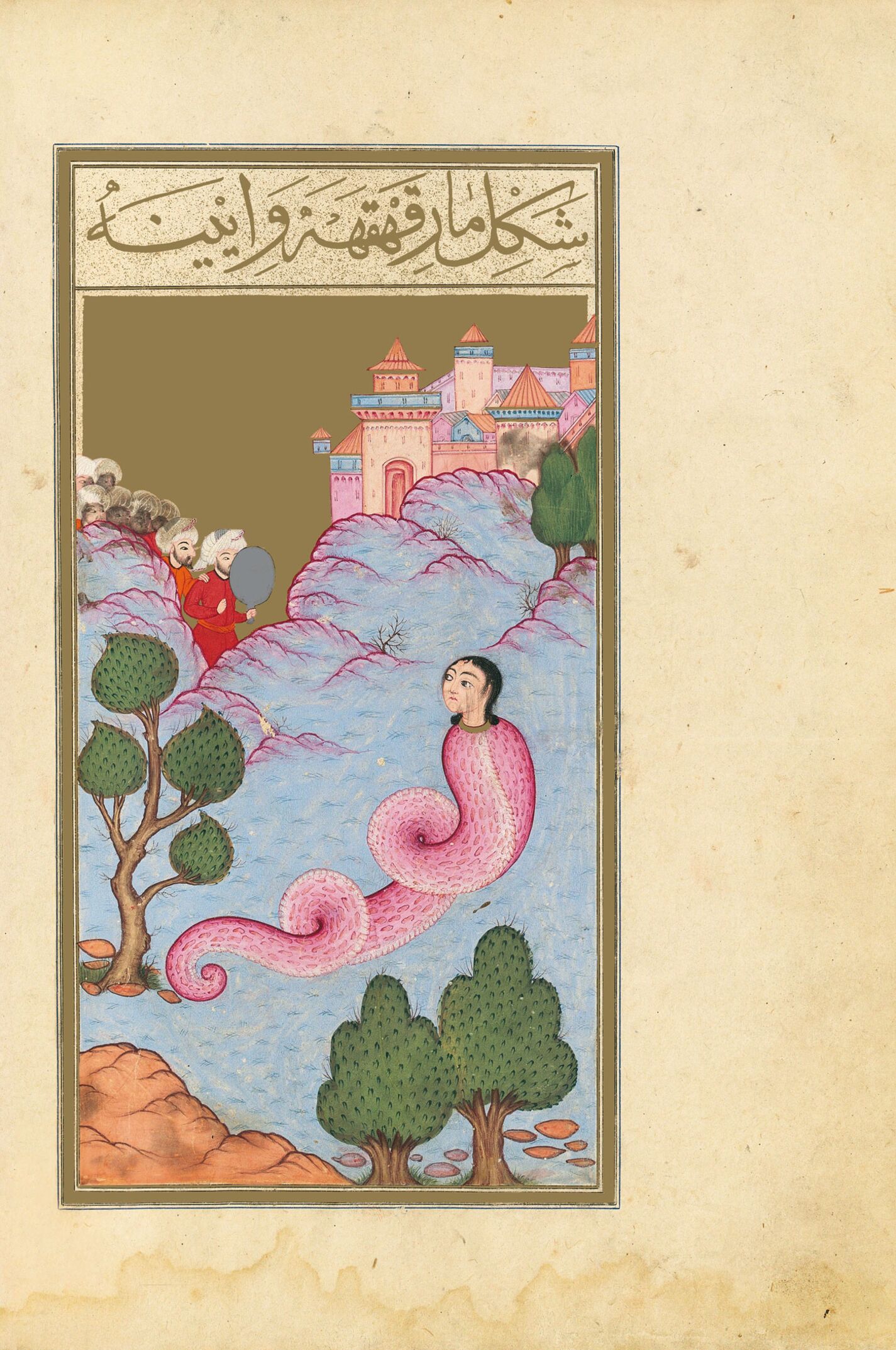The last of the full-page illustrations with a title in the cartouche above seems out of place because it is not part of the section on talismans. The sequence in the Kitab al-bulhan may have already been disrupted at the time it was used as a model in Ottoman Istanbul, so it is not surprising that the foliation of this copy and the one in the Pierpont Morgan Library is inconsistent too.
This last painting is one of the missing miniatures in the Kitab al-bulhan and its iconography is particularly interesting. The scene shows a large snake with a human head set in a secluded hilly landscape with a few trees and a walled city in the distance. A group of men appears in the distance from behind the rocks, the first one in the line holding up a large silver disk that hides his face. The human-headed snake looks in the direction of the approaching men.
The title informs us that the story is about the Laughing Snake (mar-? kahkaha) and the Mirror (ayine), which brings us to a rather complex set of ancient myths ranging from Ancient Greece to Iran. We can infer from the painting that the mirror is used by the men to protect themselves from the deadly stare of the snake, who will see its own reflection instead and die. Although the exact literary source remains unknown, the association with an extraordinary number of legends is evident: from the Gorgon who killed with her stare to the Iranian motif of the horse-phoenix that killed people by making them laugh; and from the basilisk, a reptile with a terrifying stare in Roman mythology which translates from Persian exactly as “laughing snake” to the epic Iranian figure of Dahhak, “the man who laughs”, who grew two hungry snakes on his shoulders. In addition, the mirror is another symbolic object that appears in all legends, many of which are related to Alexander the Great while others represent local derivations, such as the story of Sannaja, a sort of abominable snowman living in Tibet, as reported by the geographer al-Qazwini.
Thus, even if probably misplaced from the original sequence, this miniature represents an appropriate conclusion to an extraordinarily complex and rich series of illustrated stories without text that have no known parallels in the history of Islamic painting.
Stefano Carboni
The Metropolitan Museum of Art
Curatorial Assistant in Islamic Art
(Fragment of the Book of Felicity commentary volume)

The last of the full-page illustrations with a title in the cartouche above seems out of place because it is not part of the section on talismans. The sequence in the Kitab al-bulhan may have already been disrupted at the time it was used as a model in Ottoman Istanbul, so it is not surprising that the foliation of this copy and the one in the Pierpont Morgan Library is inconsistent too.
This last painting is one of the missing miniatures in the Kitab al-bulhan and its iconography is particularly interesting. The scene shows a large snake with a human head set in a secluded hilly landscape with a few trees and a walled city in the distance. A group of men appears in the distance from behind the rocks, the first one in the line holding up a large silver disk that hides his face. The human-headed snake looks in the direction of the approaching men.
The title informs us that the story is about the Laughing Snake (mar-? kahkaha) and the Mirror (ayine), which brings us to a rather complex set of ancient myths ranging from Ancient Greece to Iran. We can infer from the painting that the mirror is used by the men to protect themselves from the deadly stare of the snake, who will see its own reflection instead and die. Although the exact literary source remains unknown, the association with an extraordinary number of legends is evident: from the Gorgon who killed with her stare to the Iranian motif of the horse-phoenix that killed people by making them laugh; and from the basilisk, a reptile with a terrifying stare in Roman mythology which translates from Persian exactly as “laughing snake” to the epic Iranian figure of Dahhak, “the man who laughs”, who grew two hungry snakes on his shoulders. In addition, the mirror is another symbolic object that appears in all legends, many of which are related to Alexander the Great while others represent local derivations, such as the story of Sannaja, a sort of abominable snowman living in Tibet, as reported by the geographer al-Qazwini.
Thus, even if probably misplaced from the original sequence, this miniature represents an appropriate conclusion to an extraordinarily complex and rich series of illustrated stories without text that have no known parallels in the history of Islamic painting.
Stefano Carboni
The Metropolitan Museum of Art
Curatorial Assistant in Islamic Art
(Fragment of the Book of Felicity commentary volume)